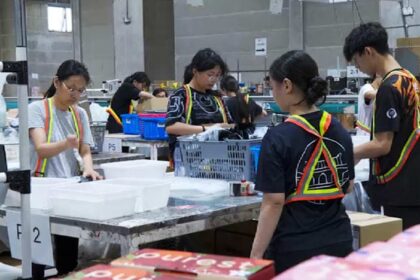Japan’s Surprising Economic Resilience in the Face of U.S. Tariffs
Japan’s economy delivered an unexpected boost in the second quarter of 2025, expanding by 0.3% from the previous quarter and 1% on an annualized basis. This performance outpaced both government and market forecasts, which had anticipated a much weaker showing amid escalating trade tensions and steep new tariffs imposed by the United States. The robust GDP figures have provided a rare moment of optimism for policymakers and investors, even as the broader outlook remains clouded by uncertainty.
- Japan’s Surprising Economic Resilience in the Face of U.S. Tariffs
- How Did Japan Outperform Expectations?
- The U.S.-Japan Tariff Deal: What Changed and What Risks Remain?
- Economic Forecasts: Growth Downgrades and Recession Risks
- Monetary Policy: Bank of Japan Faces a Delicate Balancing Act
- Political Fallout: Economic Uncertainty and Leadership Challenges
- What Lies Ahead: Risks and Opportunities
- In Summary
At the heart of this resilience was a surge in exports, particularly in the automotive sector, and a rebound in domestic demand. Despite the imposition of a 15% blanket tariff on all Japanese exports to the U.S. (with automobiles facing even higher rates for much of the quarter), Japanese firms managed to maintain shipment volumes by cutting prices and front-loading exports ahead of anticipated tariff hikes. The Nikkei 225 stock index responded positively, rising nearly 0.6% on the news, while the yen edged up against the dollar.
How Did Japan Outperform Expectations?
Japan’s Q2 GDP growth was driven by several key factors:
- Resilient Exports: Exports contributed 0.3 percentage points to GDP growth, a sharp turnaround from the 0.8% contraction seen in the first quarter. Export volumes rose 2% from the prior quarter, even as export values declined due to price cuts.
- Capital Expenditure: Business investment surged by 1.3%, surpassing consensus estimates and reflecting strong corporate spending on digital and labor-saving technologies.
- Private Consumption: Household spending edged up 0.2%, supported by wage increases at major companies and a gradual recovery in real incomes.
- Tourism: Inbound tourism provided an additional lift, with spending by foreign visitors up 18% in the quarter and arrivals reaching record highs.
These factors combined to offset the drag from tariffs and persistent inflation, allowing Japan to avoid a technical recession that many economists had feared after a weak first quarter.
Export Strategies: Absorbing Tariff Costs and Front-Loading Shipments
Japanese exporters, especially automakers, responded to the tariff threat by absorbing much of the additional cost rather than passing it on to U.S. consumers. This strategy helped preserve market share but squeezed profit margins. Many companies also accelerated shipments ahead of the full implementation of higher tariffs, boosting Q2 export volumes but potentially setting the stage for a slowdown in subsequent quarters.
According to Shinichiro Kobayashi, principal economist at Mitsubishi UFJ Research and Consulting, “Exporters rushed to ship goods even with the 10% tariff in place, fearing it could soon climb to 25%.”
Capital Investment and Domestic Demand
Business investment was another bright spot, with firms increasing spending on software, urban redevelopment, and automation. The Bank of Japan’s latest Tankan survey showed large companies planning to boost investment by 11.5% this fiscal year, up from a previous estimate of 3.1%. This reflects both a need to maintain competitiveness and a response to labor shortages in Japan’s aging workforce.
Private consumption, which accounts for nearly 60% of GDP, also showed modest growth. Wage gains from annual pay negotiations have begun to filter through to households, helping to offset the impact of inflation and higher import prices.
The U.S.-Japan Tariff Deal: What Changed and What Risks Remain?
The second quarter was marked by intense trade negotiations between Tokyo and Washington. Initially, Japan faced a 10% baseline tariff on exports to the U.S., with automobiles and auto parts hit by a punitive 25% rate. In July, a new trade agreement was reached, reducing the auto tariff to 15% and applying a 15% blanket rate to all Japanese exports. In exchange, Japan committed to a $550 billion investment package for U.S. industries, targeting sectors like semiconductors, energy, and automotive production.
While the deal provided some relief and cost certainty for Japanese exporters, the new tariff rates remain significantly higher than pre-2025 levels, when the effective U.S. tariff rate on Japanese goods was just 2%. Policy analyst Shigeaki Koga, a former official at Japan’s Ministry of Economy, Trade and Industry, explained:
“If the 15 percent tariff is maintained, its impact is unavoidable. Such tariffs will weaken Japanese exporters’ competitiveness in the U.S. market, forcing companies either to lower prices or face declining sales as Japanese products become comparatively more expensive.”
Moreover, the agreement’s implementation has been rocky. A U.S. executive order initially excluded Japanese goods from the new rates, leading to confusion and a promise from U.S. officials to correct the error and refund excess tariffs. The volatility of U.S. trade policy remains a source of concern for Japanese businesses and policymakers.
Automotive Sector: The Engine of Exports
Automobiles are the cornerstone of Japan’s export economy, accounting for over 28% of all shipments in 2024. The sector has been hit hardest by U.S. tariffs, with Toyota warning of a $9.5 billion tariff impact this year. Automakers like Toyota and Honda have responded by shifting more production to the U.S. and exploring new manufacturing opportunities, but the long-term effects on profitability and employment remain uncertain.
The trade deal also opens the Japanese market further to U.S. automakers, increasing competition at home. For Japanese firms, the challenge is to maintain global competitiveness while adapting to a rapidly changing trade environment.
Economic Forecasts: Growth Downgrades and Recession Risks
Despite the strong Q2 showing, most analysts and official bodies have revised down their forecasts for Japan’s economic growth in 2025 and beyond. The government cut its real GDP growth projection for fiscal 2025 from 1.2% to 0.7%, citing the impact of U.S. tariffs and persistent inflation. Export growth is now expected to slow sharply, and corporate investment forecasts have been trimmed.
Oxford Economics now sees Japan’s GDP growing just 0.8% in 2025 and a mere 0.2% in 2026, reflecting the ongoing drag from tariffs and global trade policy uncertainty. The Bank of Japan has upgraded its own forecast slightly, projecting 0.6% growth for the fiscal year, but warns that risks remain tilted to the downside.
Scenario analyses by Japanese think tanks suggest that if additional reciprocal tariffs are imposed or if the U.S. raises rates further, Japan’s GDP could decline by as much as 0.9% to 2.2%. The impact on the auto sector alone could shave up to 0.8% off GDP, potentially tipping the economy into recession.
Global Context: Japan’s Performance vs. Major Economies
Japan’s Q2 growth stands in contrast to slowing momentum in China, where factory output and retail sales have disappointed, and to the broader global slowdown triggered by protectionist trade policies. While Japan has so far managed to avoid the worst-case scenario, the risk of a global recession remains elevated as tariffs disrupt supply chains and dampen business sentiment worldwide.
J.P. Morgan Global Research estimates that a 10% universal tariff and a 110% tariff on China could reduce global GDP by 1%. For Japan, the direct and indirect effects of U.S. tariffs are expected to weigh on growth through 2026.
Monetary Policy: Bank of Japan Faces a Delicate Balancing Act
The stronger-than-expected GDP figures have reignited debate over the Bank of Japan’s next moves. With inflation running above target and domestic demand showing resilience, some economists now expect the BOJ to resume interest rate hikes as early as October. Financial stocks have rallied on the prospect of higher rates, which would boost bank profitability.
However, the central bank remains cautious. Governor Kazuo Ueda has signaled that further tightening will depend on continued strength in domestic demand and a careful assessment of the impact of U.S. trade policy. The BOJ’s July statement warned that global trade tensions and weakening overseas economies could weigh on corporate profits, potentially limiting the scope for rate increases.
According to Taro Kimura, an economist at Bloomberg Economics:
“Japan’s surprisingly strong second-quarter GDP bolsters the Bank of Japan’s case for a near-term rate hike, providing evidence that domestic demand is holding firm despite higher U.S. tariffs.”
Yet, with growth expected to slow in the coming quarters and inflation pressures likely to persist, the BOJ faces a delicate balancing act between supporting growth and containing price increases.
Political Fallout: Economic Uncertainty and Leadership Challenges
The economic turbulence has spilled over into Japan’s political arena. Prime Minister Shigeru Ishiba’s ruling coalition lost its majority in the upper house in July, a setback attributed in part to voter frustration over rising living costs and the government’s handling of trade negotiations. Calls for Ishiba to step down have intensified, but he has vowed to carry on and oversee the implementation of the U.S. trade deal.
The government’s ability to provide fiscal support and navigate further trade shocks will be critical in the months ahead. Analysts warn that if exports falter and corporate profits decline, pressure will mount for additional stimulus measures or tax cuts to support the economy.
What Lies Ahead: Risks and Opportunities
Looking forward, Japan faces a complex set of challenges:
- Tariff Uncertainty: The risk of further U.S. tariff hikes or policy reversals remains high, with the White House retaining the option to reinstate 25% auto tariffs if dissatisfied with Japanese compliance.
- Export Headwinds: As companies exhaust the benefits of front-loaded shipments and begin passing tariff costs onto consumers, export volumes may decline in the second half of the year.
- Profit Margins: Firms’ strategy of absorbing tariff costs to maintain market share is not sustainable in the long run, threatening profitability and wage growth.
- Domestic Demand: Sustained wage gains and robust private consumption will be crucial to offset external shocks. Real wages are expected to pick up in the fall, but inflation remains a risk.
- Investment Opportunities: The new trade agreement and strategic production shifts may create opportunities in undervalued Japanese equities and the yen, particularly as the BOJ considers rate hikes.
Despite these risks, Japan’s adaptability and the resilience shown in Q2 offer some grounds for cautious optimism. The government and central bank remain prepared to respond with policy support if conditions deteriorate.
In Summary
- Japan’s economy grew 0.3% in Q2 2025, or 1% annualized, beating expectations despite U.S. tariff headwinds.
- Growth was driven by resilient exports, strong business investment, and a rebound in private consumption and tourism.
- A new U.S.-Japan trade deal reduced auto tariffs to 15% but left Japanese exporters facing higher costs than before 2025.
- The government and analysts have downgraded growth forecasts for 2025 and 2026, citing ongoing tariff and inflation risks.
- The Bank of Japan may resume rate hikes if domestic demand remains strong, but global trade uncertainty clouds the outlook.
- Political instability and the risk of further trade shocks add to the challenges facing Japan’s policymakers.
- Japan’s economic resilience offers hope, but the coming quarters will test its ability to adapt to a volatile global environment.












